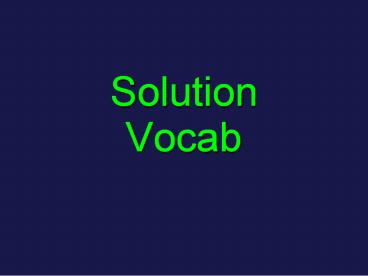Solution Vocab - PowerPoint PPT Presentation
Title:
Solution Vocab
Description:
Solutions! - Wappingers Central School District ... Solution Vocab – PowerPoint PPT presentation
Number of Views:159
Avg rating:3.0/5.0
Title: Solution Vocab
1
SolutionVocab
2
Solution
- Homogeneous mixture of 2 or more substances in a
single physical state (phase)
3
Homogeneous Mixtures
- Particles very small on atomic scale
- Cant see particles
- Cant sort particles
- Cant get trapped by filter
- Cant scatter light
- Particles evenly distributed
- Particles do not separate
4
Parts of a Solution
- Solute dissolved substance
- Solvent dispersing medium
5
Solutions occur in all 3 phases!
6
(No Transcript)
7
Gas in a liquidCO2 in and out of water
Bubbles mean its a mixture not a solution!
8
Alloys
9
Soluble
- Soluble capable of being dissolved
- A substance that dissolves in another substance
is soluble - in that substance
10
Insoluble
- A substance that does not dissolve in another
substance
11
Amounts that can dissolve
- Solubility maximum amount substance that will
dissolve in given amount of another substance - LIMITS to amounts of solutes that will dissolve
in given solvent - Temperature and pressure affect solubility
12
- Rate of dissolving is different from amount that
will dissolve! - Rate is how fast
13
Factors that affect the rate of dissolving
- Temperature
- Stirring or Agitation
- Surface Area of Solute
- Amount of solute already dissolved
14
Dissolving
- Dissolving is physical change
- All physical chemical changes accompanied by
change in energy
15
- Dissolved covalent substances
- produce molecules in solution
- C6H12O6(s) H2O(l)? C6H12O6(aq)
16
Dissolved ionic substances produce ions in
solution
NaCl(s)H2O(l) ? Na1(aq) Cl-1(aq)
17
Solvation
- Interaction between solvent molecules solute
particles - Solute particles surrounded by solvent particles
in dissolving process - Solute particles may be ions, polar molecules, or
nonpolar molecules - Solvent molecules may be polar or nonpolar
18
Hydration
- Specific name for solvent-solute interaction when
solvent is water
19
Hydration of chloride ion Also called
molecule-ion interaction
20
Solute-solvent interaction must be greater than
interaction between solute particles
for dissolving to occur
21
(No Transcript)
22
Solubility
- Amount solute dissolved in specific solvent at
given TEMPERATURE and PRESSURE - Units
- grams solute per 100 grams solvent
23
(No Transcript)
24
(No Transcript)
25
Vocabulary Interlude
- Miscible two liquids that WILL MIX
- together in any amounts
- Water and ethanol are miscible in all proportions
- Immiscible Liquids that will NOT MIX
- Oil and water are immiscible
26
(No Transcript)
27
Types of Solutions
28
Electricity
- What do you need to conduct electricity?
Mobile, charged particles!!!!
29
Vocabulary Interlude
- Electrolyte
- substance that dissolves in water to form
solution that conducts electricity - ions in solution
- Nonelectrolyte
- substance that dissolves in water to form
solution that does not conduct electricity - neutral molecules in solution
30
(No Transcript)
31
Dilute vs. Concentrated
- Tells relative amount of solute in solvent
- Concentrated
- large amounts of solute
- Dilute
- small amounts of solute
32
Which solution is most dilute? The most
concentrated? How do you know?
The stronger the color, the more concentrated the
solution
33
To dilute a Solution add additional solvent
34
Which solution is more concentrated? More
dilute? What can you say about the of solute
particles in pictures b and c?
35
Unsaturated Solution
- Less solute than maximum amount that will
dissolve at given temperature and pressure
36
Saturated Solution
- No more solute will dissolve at given temperature
pressure - Solubility amount of solute required to form a
saturated solution
37
The solution is saturated when the solute stops
dissolving
38
Dynamic Equilibrium Saturated Solution
Microscopic level Rate of dissolving Rate of
recrystallization Macroscopic level No
apparent change
39
Supersaturated Solution
- Contains more solute than saturated solution
- VERY unstable
- have to be clever to make these (need to use heat)
40
Testing for saturation
- add additional crystal of solute into solution
and see what happens
41
3 possible results
Unsaturated solution
- Crystal dissolves
- Crystal sinks to bottom of solution
- Bam! Suddenly have lots of solid solute in
beaker
Saturated solution
Supersaturated solution
42
(No Transcript)
43
(No Transcript)
44
How do terms saturated, unsaturated
supersaturated fit in with the solubility
curves?
45
- Saturated solutions
- maximum solute that will dissolve at given
temperature - any point on trace lines represent saturated
solutions
46
- Supersaturated solutions
- all points above trace lines represent
supersaturated solns
47
- Unsaturated solutions
- all points below trace lines represent
unsaturated solutions
48
Characterize points A, B, C, D with respect to
KNO3 trace line (dilute, concentrated,
saturated, unsaturated, or supersaturated)
A,C concentrated supersaturated Bconcentrat
ed saturated
49
Summary of Dissolving
- Occurs surface of solid
- Interaction between solute solvent
- Interaction called solvation
- If water is solvent, interaction called
hydration - Involves change in energy
50
(No Transcript)
51
Solubility Information
- Often presented in graphs
- Graph show grams substance that can dissolve in
water between 0oC and 100oC - Trace line represents saturated solution
- above trace line represents supersaturated
solutions - below trace line represents unsaturated solutions
52
Solubility Graphs
- Traces have positive or negative slopes
- Most solids have positive slope
- the hotter the water, the more solute dissolves
- The colder the water, the less solute dissolves
- All gases have negative slope
- the hotter the water, the less gas dissolves
- The colder the water, the more gas dissolves































